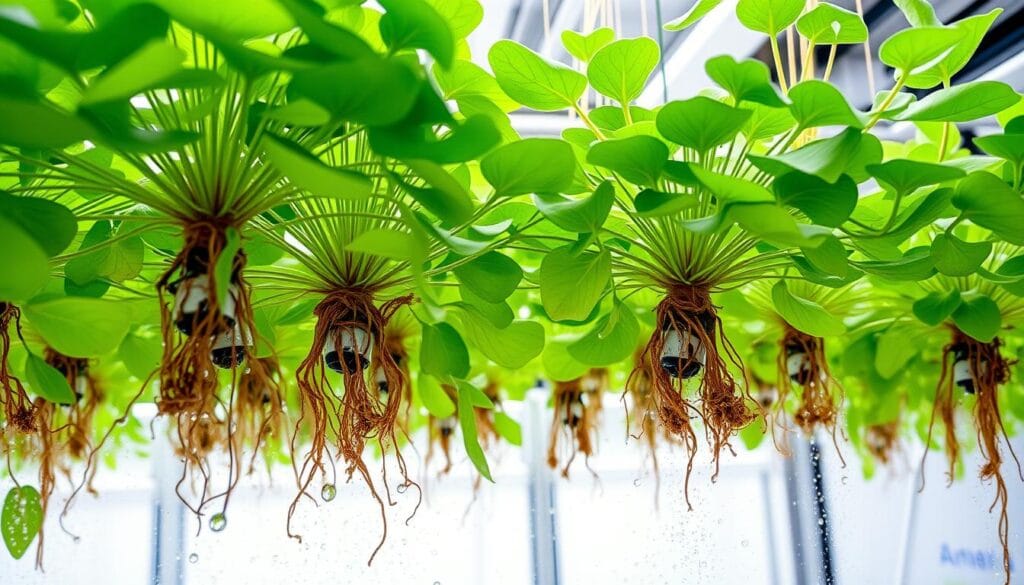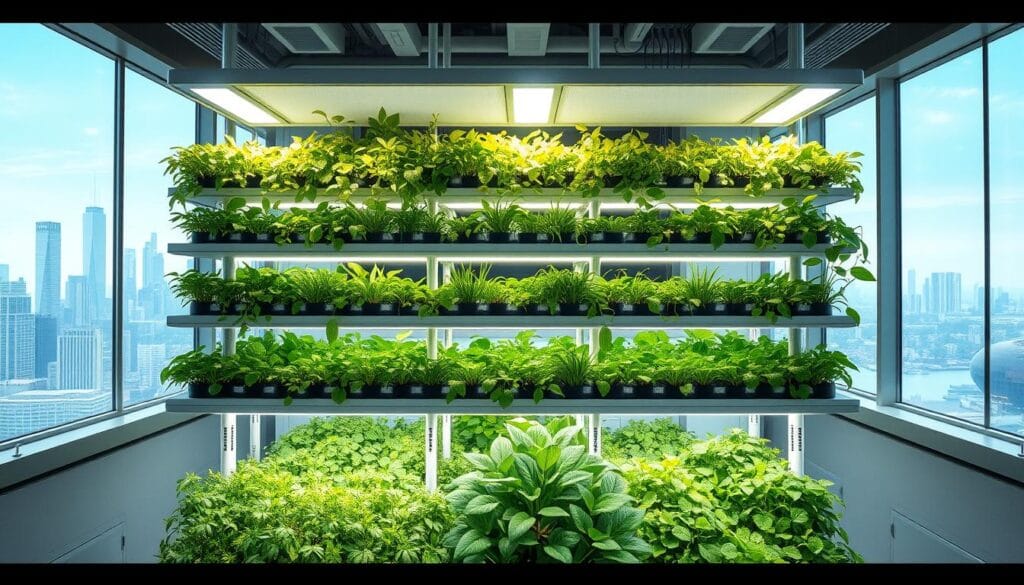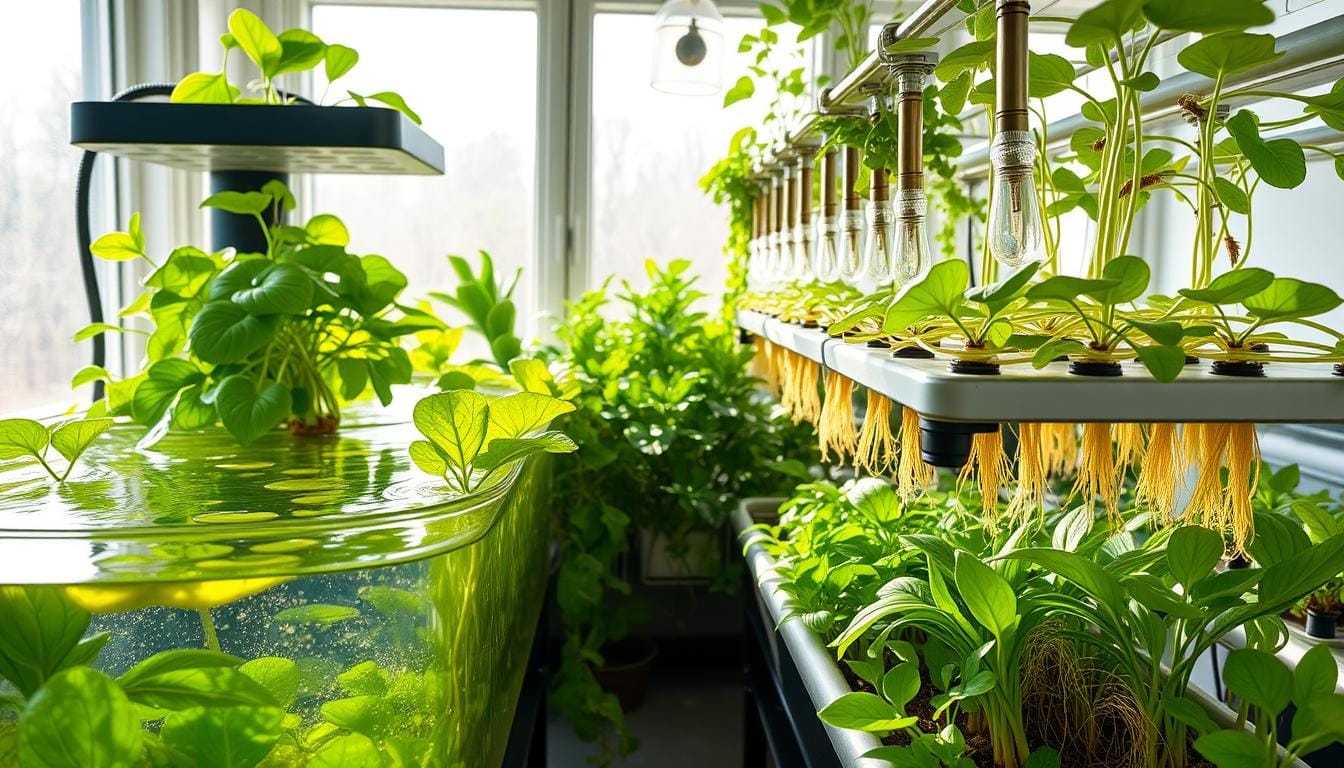Aeroponics or Hydroponics: I’ve always been excited about growing plants without soil. The idea of soilless cultivation has intrigued me for years. I’ve spent a lot of time learning about the latest in sustainable agriculture. Recently, I discovered aeroponics and hydroponics, and I’m eager to share what I’ve learned.
Aeroponics and hydroponics are new ways to garden without soil. They offer many benefits, like higher yields and less water use. They also let you grow plants in cities. When starting your garden, it’s key to know the differences between these systems. This will help you choose the best one for your goals and what you have available.
Key Takeaways
- Aeroponics and hydroponics are soil-free growing methods that offer higher yields and greater sustainability compared to traditional farming.
- Aeroponics suspends plant roots in the air and mists them with nutrient-rich solutions, while hydroponics grows plants in a water-based, soil-less environment.
- Both systems use significantly less land, water, and energy, making them environmentally friendly options for modern agriculture.
- Factors to consider when choosing between aeroponics and hydroponics include cost, technical complexity, maintenance requirements, and environmental conditions.
- Aeroponic and hydroponic systems are versatile and can be used for a wide range of crops, from leafy greens to high-value produce.
Understanding Soilless Growing Systems
Soilless growing systems are changing how we farm. They give plants nutrients directly, without soil. This lets us grow food all year, no matter the weather.
The Evolution of Modern Agriculture
Climate change, soil loss, and water scarcity are big problems. Soilless farming, like hydroponics and aeroponics, is a new way to farm. It can grow more food, use less water, and even grow in cities.
Basic Principles of Soilless Cultivation
Soilless farming gives nutrients straight to the roots. This means we can control what plants get, how they grow, and how much they produce. It uses special equipment and media, not soil.
Why Choose Soil-Free Growing Methods
Soilless farming is good for the planet. It uses less water, fights off diseases, and fits in tight spaces. It’s a better way to grow food for a growing world.
Vertical farming stacks plants in small spaces. Controlled environment agriculture lets farmers control the environment for plants. This means plants grow well all year.
| Key Benefits of Soilless Growing Systems | Aeroponics | Hydroponics |
|---|---|---|
| Water Efficiency | 98% less water than traditional farming | 30% less water than traditional farming |
| Nutrient Uptake | Efficient nutrient absorption due to direct root exposure | Nutrients delivered through water-based solutions |
| Growth Rates | Up to 70% faster growth compared to hydroponics | Faster growth than traditional soil-based farming |
| Pest and Disease Control | Eliminates soil-borne pests and diseases | Reduced risk of soil-borne issues, but can still face some pest challenges |
| Scalability | Highly suitable for vertical farming and urban agriculture | Requires more horizontal space compared to aeroponics |
As the world’s population grows, we need more food. Soilless farming is a key solution. It uses vertical farming and new ways to grow food, making our food system better for the planet.
What is Hydroponics: A Comprehensive Overview
Hydroponics revolutionizes agriculture by enabling soil-free cultivation. Instead, plants get nutrients from water. This method is becoming popular in farming, offering a green and efficient way to grow food.
Hydroponics uses different systems to feed plants. You might have heard of deep water culture (DWC), nutrient film technique (NFT), and ebb and flow systems. Each system has its own benefits, helping growers choose the best method for their plants.
- Deep water culture (DWC) systems soak plant roots in nutrient-rich water. This keeps roots oxygenated and fed.
- Nutrient film technique (NFT) systems flow a thin stream of water over roots. This keeps roots constantly fed.
- Ebb and flow systems flood roots with water, then drain it. This mimics the ocean’s tides.
Hydroponics is very efficient. It can grow 20 times more food than soil farming, using 90% less water. This shows how innovative hydroponics is.
“Hydroponics offers a sustainable solution to the growing global demand for food, providing a path towards more efficient and environmentally-friendly agricultural practices.”
As we face climate change and resource shortages, hydroponics is key. It saves water, cuts down on pesticides, and allows for growing food all year. This method promises a greener future for cities and farms alike.
Exploring Aeroponic Systems
Aeroponics is a new way to grow plants without soil. Plants hang in the air, and their roots get misted with nutrients. This method grows plants faster and uses less water than old farming ways.
Core Components of Aeroponic Setup
An aeroponic system has key parts like misting nozzles, nutrient tanks, and timers. These work together to give plants the oxygen and nutrients they need to grow well.
Nutrient Delivery Methods
Aeroponics provides nutrients to plant roots via a fine mist. This method gives plants exactly what they need for fast growth and high yields. Keeping the nutrient solution right is key for healthy plants.
Environmental Control Requirements
Keeping the right conditions is vital for aeroponics. Plants need high humidity and stable temperatures to grow well. Advanced tech helps control these factors, helping plants thrive in the air.
Aeroponics is great for growing in cities or indoors. It grows plants faster and better than old ways. It’s changing how we farm today.
Aeroponics or Hydroponics: Understanding the Key Differences
Soilless gardening has two main methods: aeroponics and hydroponics. The main difference is how nutrients reach the plants. Hydroponics keeps roots in a flowing nutrient solution. Aeroponics, on the other hand, sprays roots with nutrient-rich water.
This difference affects nutrient absorption, oxygen exposure, and root health. Aeroponics gives roots more oxygen, leading to faster growth and higher yields. But, it needs precise control to work well. Hydroponics is simpler to start with, making it great for new growers.
| Feature | Hydroponics | Aeroponics |
|---|---|---|
| Nutrient Delivery | Roots submerged in or exposed to nutrient solution | Roots suspended and misted with nutrient solution |
| Oxygen Exposure | Moderate | High |
| Nutrient Absorption | Efficient | Highly efficient |
| Setup Complexity | Easier | More complex |
| Maintenance | Relatively simple | Requires more attention |
| Yield Potential | Significantly higher than soil-based methods | Potentially slightly higher than hydroponics |
Both methods can outperform traditional soil gardening, with aeroponics possibly leading. The choice depends on budget, space, skill level, and crop needs.

Aeroponic Tower Maintenance
Keeping an aeroponic tower in top shape is all about paying attention to the little things. It’s important to check the system regularly to keep plants healthy and growing well. This means watching the nutrient solution levels and making sure the pH is just right.
Regular System Checks
- Check the water quality and pH level often to keep it perfect for your plants.
- Keep an eye on the nutrient solution levels and add more when needed for strong plant growth.
- Make sure the misting system is working right by checking for clogs or blockages.
- Look for pests or diseases on the roots and leaves and deal with them fast.
Cleaning and Sanitization Protocols
It’s crucial to keep the aeroponic tower clean to stop algae, bacteria, and other harmful stuff from growing. Regular cleaning of the reservoir, tubing, and other parts helps keep the growing area healthy and full of life.
- Clean the reservoir well and sanitize it with a mild bleach solution or a special cleaner.
- Flush the system with clean water to get rid of any leftover cleaning stuff.
- Wipe down the tower and its parts to remove dirt and debris.
- Disinfect the misting nozzles and tubing to stop disease or pests from spreading.
Troubleshooting Common Issues
Aeroponic systems sometimes run into problems, but with the right troubleshooting, you can fix them fast. Watch the system closely and fix any issues quickly to keep your plants growing well.
- Blocked nozzles can mess up the misting, leading to uneven nutrient delivery. Clean or replace them as needed.
- Problems with nutrient levels can cause growth issues or deficiencies. Adjust the solution accordingly.
- Power outages or timer problems can mess up the misting cycle, stressing plants. Make sure you have backup power and the timer works right.
By taking good care of your aeroponic tower, you can create a thriving space for growing. This innovative method without soil can really pay off if you keep it well-maintained.
Cost Comparison and Initial Investment
Setting up a soilless growing system can cost differently for aeroponics and hydroponics. Aeroponics need special equipment like misting parts and timers, making it pricier. Hydroponics, on the other hand, is easier to start with simpler setups and fewer parts.
But, the ongoing costs for both systems are similar. You’ll spend money on electricity, water, and nutrients. This makes the long-term costs about the same.
| Cost Factor | Aeroponics | Hydroponics |
|---|---|---|
| Initial Setup Costs | $300 – $1,000 for small-scale setups, up to tens of thousands for larger commercial systems | Generally lower than aeroponics, with simpler and more affordable setups |
| Nutrient Costs | $20 – $100+ per month | Comparable to aeroponics, depending on system size and plant needs |
| Electricity Costs | $20 – $100 per month for running pumps, timers, and grow lights | Can be similar to aeroponics, depending on equipment efficiency |
| Maintenance Costs | $50 – $200 per year for replacement parts like mist nozzles, pumps, and timers | May be higher than aeroponics due to the need for growing medium replenishment |
The choice between aeroponics and hydroponics depends on your goals and resources. Both can lead to high yields and better use of resources. But, think about the initial costs and ongoing expenses before deciding.
Environmental Impact and Sustainability
Aeroponic and hydroponic systems are better for the environment than traditional farming. They use up to 98% less water and need less land. This makes them very efficient and good for the planet.
Water Conservation Benefits
Aeroponics uses even less water than hydroponics. It sprays a nutrient-rich solution on the roots, saving up to 95% of water. This is great for places where water is scarce.
Energy Efficiency Considerations
The energy use of aeroponics depends on the lighting. But, new LED tech and better control of the environment have made it more energy-efficient.
Carbon Footprint Analysis
Aeroponics and hydroponics grow crops in cities, cutting down on transportation emissions. Using renewable energy helps even more. While there are some emissions from making and throwing away parts, these systems are still very green.
| Metric | Aeroponics | Hydroponics | Traditional Farming |
|---|---|---|---|
| Water Usage | 95% less | 70% less | Baseline |
| Energy Consumption | Moderate | Moderate | Low |
| Carbon Footprint | Reduced | Reduced | Baseline |
Aeroponics and hydroponics are good for the planet. But, their full sustainability depends on energy, waste, and how big they can get. As they improve, focusing on being green and efficient will help them even more.
Space Requirements and Scalability
In vertical farming and urban agriculture, using space wisely is key. Both aeroponic and hydroponic systems are great at growing more in less space. This allows for growing more food within a compact space.
Aeroponic towers are super good at saving space. They can fit lots of plants in a small area. This makes them perfect for cities or places with little ground space.
Hydroponic systems are very flexible. They can be small, like for growing herbs, or big for large farms. They fit any space optimization need you have. Whether it’s a few herbs or a big urban agriculture project, hydroponics can handle it.
- Aeroponic towers maximize yield in limited spaces through vertical growing.
- Hydroponic systems provide design flexibility, from small to large-scale operations.
- Both methods are well-suited for urban agriculture, allowing food production in cities and unconventional spaces.
“Embracing the power of soilless cultivation techniques like aeroponics and hydroponics opens up a world of possibilities for maximizing your growing space, whether you’re a small-scale urban gardener or a commercial-scale producer.”

Using these innovative growing systems lets you grow more food in less space. This changes how we think about farming and using resources wisely.
Crop Yields and Growth Rates
Aeroponic and hydroponic systems greatly improve plant productivity and how often you can harvest. Aeroponics can produce three times more than traditional farming. Hydroponics can even yield up to 20 times more. This is because these systems deliver nutrients perfectly and control the environment.
These methods let you grow many different crops all year round. You can cultivate a variety of crops, from leafy greens to fruit-bearing plants. This means you can always have fresh, high-quality food available.
Also, these systems use nutrients very efficiently. This means less waste and a smaller environmental impact. Exploring aeroponic and hydroponic systems opens up new possibilities for growing more food faster and more sustainably.

